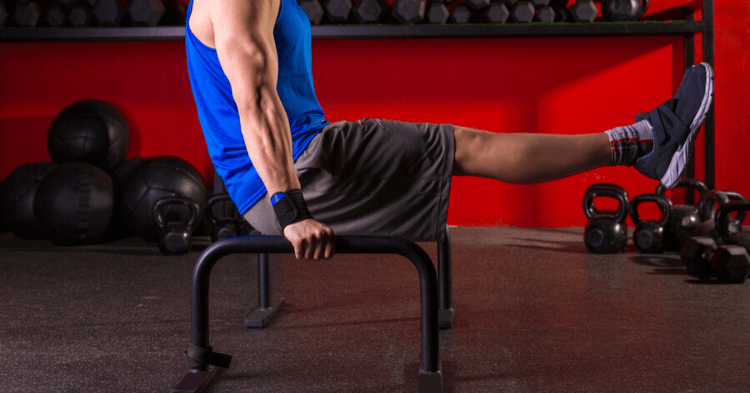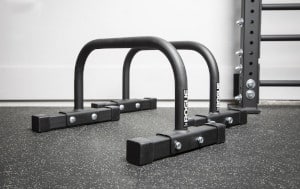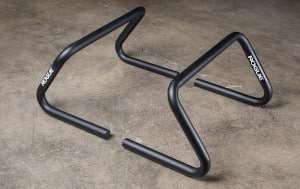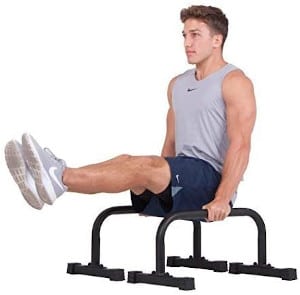
Gymnastic strength training and bodyweight training are a great way to build strength and muscle mass at home. They’re simple pieces of equipment that offer varied and effective home workouts.
Today we’re discussing the Parallette, a set of low bars that are invaluable to gymnasts around the world. If you’re looking to get stronger and improve your physique with bodyweight training, they’re an amazing investment.
Let’s get started with our review of some of the most popular parallettes on the market.
Contents
1. Vita Vibe Parallettes

The product is strong yet flexible, with the gymnastic standard ash bar and a powder-coated steel base at each end of each Parallette. With a 10-year warranty, this product comes with amazing assurances.
The only real concern we can see is the unfinished and un-covered top bolt on the steel base. Obviously, this makes any potential slips or accidents more risky for injuries – and should really be capped or finished accordingly.
Overall, this is a simple and effective take on the Parallette, and the 24” model is well regarded for its durability and design quality. This wooden design is unique for this list, and it’s a huge plus for its comfort and overall quality.
- Great ash beam for support and comfort
- Solid metal base, offering stability and security during exercise
- High quality, durable, and reliable
- 10-year warranty as standard
- 18″ version is a little shorter than we’d like
- Exposed bolt is a concern and could do with coverage
2. Rogue Bolt-Together Parallette Set (Pair)

The Rogue Parallette is the fitness giant’s answer to the standard gymnastic Parallette. Right off the bat, it’s clear these are parallettes for CrossFit and not for gymnastic strength training specifically.
With a 100% metal construction, they forego the familiar hardwood bars in favor of steel tubing. This makes them less comfortable to use and less specific to the gymnastic training for which parallettes are designed.
This isn’t a deal-breaker for the average joe, but it does set them apart from the gymnastic style. The product also weighs significantly more than traditional parallettes or even the metal-base style from Vita Vibe.
On the other hand, these do have increased height and thus allow for better clearance. You’re going to be able to perform a wider variety of exercises with the Rogue bars than the Vita Vibe style, without requiring as much strength or familiarity.
We’re not sure this lives up to the same distinctive function you’d see with other Rogue products, and the ash style is definitely a timeless classic for a reason. A good product, but potentially not the best on our list today.
- Decent overall quality, durability, and reliability
- Very stable, perhaps the most stable on our list today
- Reliable brand with a good customer service reputation
- More expensive than comparable products
- Metal construction is inferior to ash bars/supports
3. Ultimate Body Press Parallettes

These offer many of the same features – down to the specifications – of the Rogue product but without the heavy-duty construction. The rubberized feet speak to reduced quality, and the overall design and build quality are slightly below the standard the prior product sets.
On the other hand, these are also available at a fraction of the price of the Rogue product, making them our first ‘economy’ option on this list. They’re also cheaper than the Vita Vibe set, despite being made of metal instead of finished wood.
If you’re just looking to improve the quality of your push-ups and L-sits at home, and don’t care too much for the specifics, this is your cash-saving option. It’s significantly cheaper, and that could be all the justification you need to choose this product!
- Great economy: a solid price-tag for a good product
- Standard 12″ clearance for beginner use
- Great standards compared to more expensive products like Rogue
- Rubberized feet do have some problems
- Not as heavy-duty or high-quality as the Rogue products
4. Rogue Formed Parallette Set

This is the Rogue take on an economy Parallette set – and it’s more expensive than our last bolt-together economy set while still being an inferior product. The overall build and quality of this product is questionable by comparison, with far less stability and durability.
It’s a pre-formed set, with no moving parts. However, this also means that it’s not got the build quality and overall heavy-duty design we like to see in a Parallette. They’re not necessarily meant to be dense, but they’re designed with stability in mind, and this product under-performs there slightly.
The design is light-weight and surely easy enough to store, but these definitely aren’t the most comfortable thing to use. There’s always a little bit of doubt in the security of the product, though the clearance is an enormous 13.5” (3.5” higher than vita vibe).
This makes them more accessible and easier to use with less strength/experience, possibly making them more appropriate for beginners who have a weak tuck position. Overall, however, we can’t see any reason these would out-perform the prior product – on economy or function.
The overall idea is a little wasted when Rogue’s bolt-together parallettes are superior, and the non-Rogue alternatives are already cheaper and more effective than the pre-formed parallette option!
- No construction required
- Easy to store and move
- Unstable compared to bolt-together parallettes
- Inferior to wooden bars/supports
- Not cheap enough to justify reduced functionality
5. Body Power Non-Slip Parallettes

On top of this, this product seems less stable overall, and existing customers do often report it is wobbly or unstable. This is unsurprising given many of the quality assurance issues that surround the machining of the product and its fastening nuts/bolts.
Even beyond this, the metal design is still inferior to a good, gymnastic-standard wooden bar. There’s a reason this has been the design of choice for P-bars and parallettes for centuries: it’s the most comfortable and faithful gymnastic (strength) training experience.
- Decent economy, with a good price point for its overall functionality
- Standard 12″ clearance for easier accessibility
- Less stable than relevant competitors
- Poor rubberized feet performance
- Quality assurance issues surrounding machining and attachments
- Wobbly and unreliable compared to market alternatives
6. XTEK Gym Parallettes

This can be very uncomfortable since it distributes the weight across a much smaller region. This, combined with the metal construction instead of wood, makes it a very uncomfortable product to use.
This product does have amazing clearance compared to the other products we’ve looked at so far, with a staggering 14.5” of standard height. This would be great for beginners on any other product, but the positioning of the hand and wrist just don’t feel comfortable, even if pass-throughs are easier for beginners.
The overall design is very tall but fails some of the more important fundamentals of good parallette design.
- Significant 14.5″ clearance makes it very accessible
- Overall quality is pretty good with the lower-than-average price
- Bar is thinner than the standard wooden or metal designs on this list
- Can be uncomfortable or unstable for many people, unduly stressing hands
7. Tumbl Trak Portable Parallette Bars

However, it does still offer many of the core functions like improving press-up positioning, offering more advanced options, and is obviously easy to store and move. It’s a much smaller product overall and costs less – but not much less – than others on our list so far.
The overall vibe we get from this product is that it’s got a specific appeal for those in gymnastics but doesn’t translate over well to gymnastic strength training or bodyweight training at home for muscle, strength, or health.
It certainly underperforms compared to the other products on this list – economy and otherwise.
- Very interesting and convenient design
- Easy to transport, store, and set up for exercise
- Very low clearance
- Niche appeal and lacks some exercise variety
- Not as high-quality materials as the prior exercises
8. Lebert Parallettes

First, the clearance is relatively weak compared to other products on this list: 12” is roughly standard, but this list has seen better (and worse).
On top of this, the actual design of the parallettes base of support is small and unstable. It’s a light product overall, which has its advantages, but it is also unstable compared to the metal base products mentioned above, and even standard wooden gymnastic parallettes.
The design being small does provide easy movement and travel, but comes at the cost of the heavy-duty design and the stability we look for in most parallettes.
Overall, it’s an economical product but not sufficiently to justify the weaknesses of function. The quality of material and the overall design do also put immense pressure on the hands with a weak finishing foam for the handles, and many customers have complained about quality assurance and machining/finish quality!
- Interesting design
- Relatively cheap compared to some alternatives on this list
- Materials used are not reliable and often produce discomfort
- Shorter than the 24″ standard for parallettes
- Quality assurance and not cheap enough to justify existing problems
- Relatively light design, with reduced weight rate and overall usefulness
FAQs About Parallette Bars
Parallettes are pretty niche – let’s look at some of the most important questions people have about them.
How Tall Should Parallettes Be?
This depends on what you’re using them for. We generally look for 10” or greater, and 12” is a better standard for most people. The higher a Parallette is, the more accessible it can be for beginners: the higher position puts less demand on the tuck position and helps beginners get comfortable with the training.
However, parallettes at a much lower height are totally reasonable and popular among gymnastic training enthusiasts. For the less-specific training of a home gym or fitness enthusiast, a higher Parallette is going to be a better choice.
The idea is to get into Parallette training and have plenty of options, building strength and skill over time. A higher parallettes (10”+) is the best choice for this kind of training.
Parallel Bars vs. Parallettes
Parallel bars are a huge piece of equipment and an enormous expense. These are the concerns faced by someone looking for a parallel bar training setup and is how people are led to parallettes.
The parallettes are a home workout option and can be transported easily, while parallel bars are over 11 feet long, heavy-duty, and bolted into the floor. There’s a clear difference here – and that combines with the fact that parallel bars are unbelievably expensive.
If you’re not an elite gymnast, you don’t need parallel bars at home. If you are an elite gymnast, you should be doing your P-bar workouts at a gymnastics center!
Parallettes are a good way of fitting your gymnastic strength training, but doesn’t involve the same gymnastic movements, cost, effort, permanency, or difficulty of set-up. They’re basically the kind of thing you would use to train for gymnastics if you didn’t do gymnastics.
How Do You Choose a Parallette?
The things you want to consider include: height, bar material, stability, durability, and additional features.
These all play into the quality of a product in their own way – as you’ll see in our reviews above. These are all independent variables, and it’s possible to do 3 of them really well, but still fail on one of them badly.
The best Parallette is the one that has the best functionality, and then the best economy after that. These are the key features unless you have very specific personal needs. You need to know what you want it for, because that will play into which factors are a priority for your purchase!
What Muscles Do Parallettes Work?
This depends on the exercises you’re performing – but they are going to be primarily aimed at the muscles of the upper body and core. You can train the muscles of the lower body with L-sits, but these aren’t very effective, and the overall design aims at improving the muscles of the upper body.
The main muscle groups worked by a Parallette, through standard exercises like planks, levers, other holds, and push-up variations include:
- Triceps
- Shoulders
- Muscles of the scapula
- Lats
- Chest
- Abdominals
- Obliques
- Biceps
- Hip flexors
So, basically, every muscle group above the hips!
Can You Use Push Up Bars As Parallettes?
This depends on what you’re using parallettes for! You can use parallettes as push up bars, but not the other way around.
Push up bars are like a very short version of parallettes that offer a much-reduced form of exercise functionality. They’re not going to be stable enough or long enough for many exercises, especially those involving balance, like the planche.
The variety of exercises you can perform with parallettes is much greater, and these are also more specific to the demands of gymnastic training and gymnastic strength training. If you’re only using it for push-ups, you could consider the two interchangeable, but that misses out on the point of having parallettes!
Conclusion
Our top pick when it comes to parallettes is the set we opened with: the Vita Vibe pair. These offer the best combination of stability and comfort and, while the clearance is a little less than ideal, they’re the most functionally useful.
The Vita Vibe parallettes offer the quality of a decent set of P-bars with the convenience and ease associated with Parallettes. They strike a beautiful balance and offer a quality experience for a home bodyweight workout.
If you’re looking for an economical alternative, the Ultimate Body Press parallettes are a great choice. These are effective at a low cost, which could be perfect for your own needs.